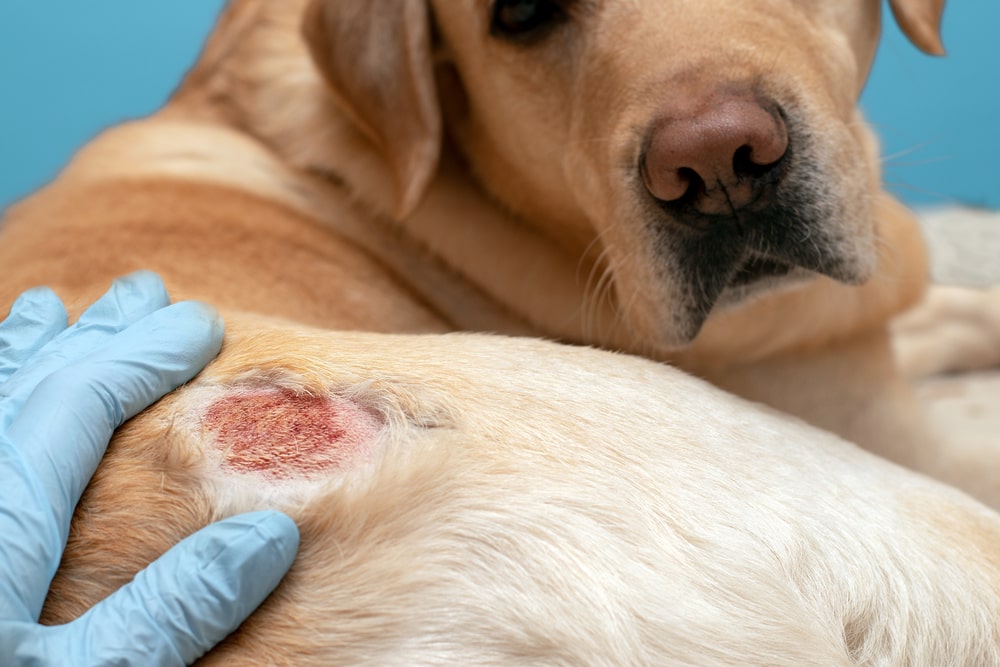Having an itchy dog is a common problem for owners as there are a variety of causes, often stemming from issues with their skin or an allergic reaction. It can be uncomfortable for them and can lead to more serious skin infections if they constantly scratch, lick or bite at their skin.
Spotting excessive scratchy and biting of the skin is quite easy, but it is useful to know another sign is coat staining. Excessive licking can cause saliva staining of their coat which can be brown, red, orange or pink in colour and is commonly seen between the toes and on the feet or legs.
In order to help them it’s important to work out what is causing the itch. Here are the main culprits:
Parasites
- Fleas: By far the most common cause of itching. Even a few fleas can cause intense itching, especially if your dog has flea allergy dermatitis (FAD), an allergic reaction to flea saliva. Fleas and their eggs can also live in your home so it’s important to treat your carpets and soft furnishings as well as your dog in order to get rid of them properly.
- Mites:
- Ear mites: Live in the ears and cause itchy, red, waxy ears, often leading to ear infections.
- Sarcoptes mites (Scabies/Mange): These tiny mites burrow into the skin, causing intensely itchy, crusty skin, and hair loss, often around the ears, elbows, legs, and belly. This is a highly contagious skin condition and dogs can pick it up from other dogs or foxes.
- Demodex mites: these mites are microscopic and naturally live on a dogs skin, but an overgrowth can cause hair loss and red, crusty, scaly skin, especially around the eyes and feet. More common seen in puppies or dogs with weakened immune systems.
- Cheyletiella mites ("walking dandruff"): These white mites are quite rare in UK due to our use of flea and tick preventative medications. They cause flaky, itchy skin, are highly contagious, living on the surface of the skin feeding on skin debris and fluids.
- Lice: Less common in well-cared-for indoor dogs, but can cause itchy, dry, flaky skin and hair loss.
- Ticks: While not primarily causing widespread itching, tick bites can cause localised irritation and can transmit diseases.
Allergies
Skin allergies are common in our dogs for a variety of reasons, including:
- Environmental Allergies (Atopic Dermatitis): This is very common, similar to hay fever in humans. Dogs can be allergic to airborne particles such as:
- Pollen (from trees, grasses, weeds)
- Dust mites (common in homes)
- Mould spores
- Dander from other animals.
Symptoms often include itchy skin (especially paws, face, ears, and belly), redness, inflammation, coat staining from excessive licking and sometimes secondary skin infections. You might only see this in the spring and summer, or it can be a problem year-round.
- Food Allergies: Dogs can develop allergies to certain ingredients in their food, even after eating them for years. Common culprits include proteins like beef, chicken, dairy, wheat, lamb, soy, and eggs. Symptoms often include itchy skin (including itchy ears, face, and paws) and/or gastrointestinal issues (vomiting, diarrhoea, or wind).
- Contact Allergies: These are less common, but can occur when a dog's skin directly touches an allergen, such as:
- Certain plants
- Cleaning products
- Synthetic fibres in carpets or bedding
- Some topical medications.
- Insect Bites and Stings: Beyond fleas, other insect bites (e.g., mosquitoes, spiders, wasps, bees) can cause localised itching, redness, and swelling.
Skin Infections
- Bacterial Infections (Pyoderma): Often a secondary issue to underlying allergies or parasites, caused by scratching or licking the skin, which causes red patches, sometimes with a pungent smell, The infections are commonly called “hot spots” and can be localised or widespread.
- Yeast Infections (Malassezia Dermatitis): These can occur when there's an overgrowth of yeast on the skin, often in conjunction with allergies. They cause a distinct musky odour, greasy coat, and itchy, thickened, sometimes darkened skin. Yeast infection can occur if there is excessive licking and are commonly seen between the toes as well as in skin folds, in ears, armpits and groin area where there is less air flow and trapped moisture.
- Fungal Infections (e.g., Ringworm): Although less common, ringworm (which is a fungus, not a worm) can cause circular patches of red, raised, hairless, itchy skin.
Other Causes
- Dry Skin: Especially in low humidity environments or if the dog has a poor diet.
- Hormonal Imbalances: Conditions like hypothyroidism or Cushing's disease can lead to skin problems, including itchiness, hair loss, and flaky skin.
- Boredom or Anxiety: Some dogs may excessively lick, chew, or scratch themselves as a behavioural response to stress or lack of stimulation.
- Underlying Medical Conditions: Rarely, other systemic diseases can manifest with skin symptoms.
When to see a vet
If your dog is scratching, licking or chewing their skin excessively, has red or sore skin, excessive saliva staining of the coat, hair loss, scabs, or any unusual skin symptoms, it's always best to consult your vet. They can properly diagnose the cause of the itching and recommend the most effective treatment, which might involve medication, dietary changes, parasite control, or specialised shampoos.

